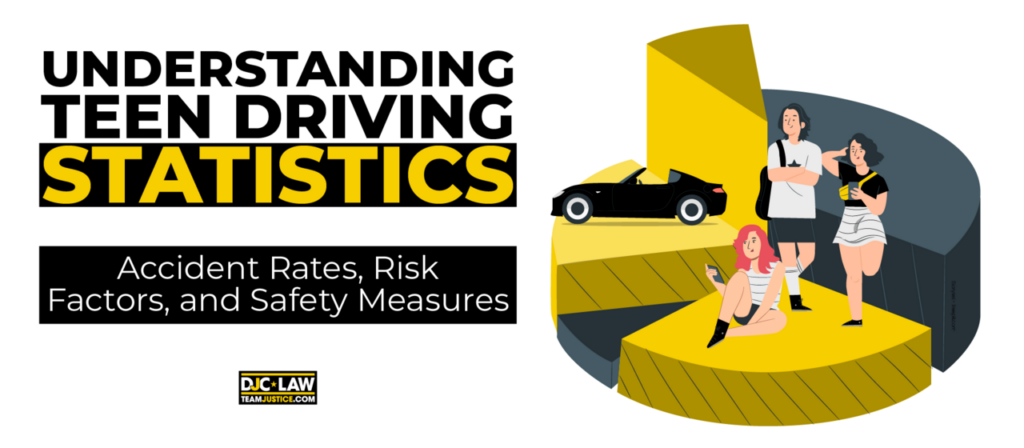
Student drivers come with warning labels, but most inexperienced drivers don’t. Simple mistakes might lead to stalling at a red light and earning the ire of your fellow driver. Still, inexperienced drivers are more likely to be involved in serious accidents than anyone else.
If we look at the numbers from the Insurance Institute for Highway Safety, the death rate per mile driven is four times higher for teen drivers than all other demographics combined. It’s often not because they’re reckless but because they lack experience.
In an effort to improve teen driving safety and protect others from catastrophe, we’ve examined teen driving stats to learn more about how they drive and why teen accident rates are so high.
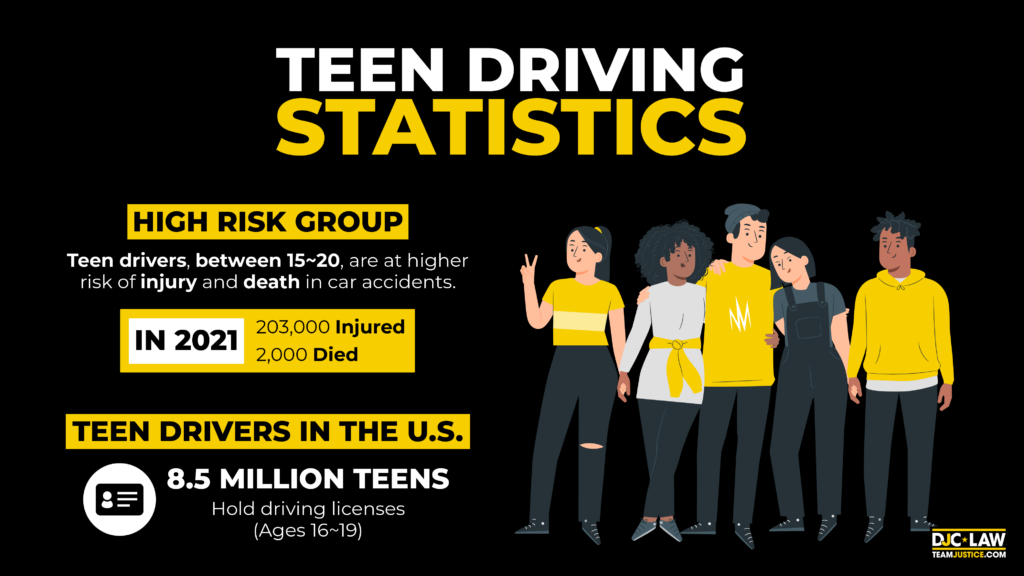
Key Takeaways
- Teen drivers make up the majority of serious accidents and fatalities on America’s roadway, even though teen drivers make up fewer than 5% of all licensed drivers.
- By far, the most significant cause of fatal accidents among teens is distracted driving, but speeding and DUIs aren’t far behind.
- More teens are injured in car accidents than any other group because of a lack of experience and a natural inclination toward risk-taking behavior.
- Teen driving insurance premiums are the highest of all age groups, but you can reduce these rates by shopping around, putting them on an existing policy, or taking advantage of special teen-related discounts.
- Teens can decrease their risk of being involved in an accident by taking classes, knowing their vehicles, avoiding night driving, and practicing safe driving habits.
- If your teen is involved in an accident, they must call law enforcement and hire a lawyer to pursue their insurance/personal injury claims.
Teen Driving Statistics: Research and Data
Teen drivers are at the greatest risk of injury and death on America’s roadways. In 2021, the National Highway Transport Safety Administration (NHTSA) recorded 203,000 drivers between the ages of 15 and 20 sustained an injury in a car accident, representing a 7% increase from 2020.
If we look at the numbers reported from AutoInsurance.com, we see an average of six young drivers every day, totaling around 2,000 deaths annually. The truly stunning statistic, as reported by News Nation, is that drivers aged 19 or under comprise just 3.6% of America’s licensed drivers.
It’s clear that teens have an outsized number of accidents and represent a huge number of roadway deaths. Understanding why this is the case and what can be done about it is critical if we’re going to take steps to change these sobering numbers.
How Many Teens Are on the Road?
The number of teenagers aged 16 to 19 with driving licenses in the U.S. is 8.5 million, according to statistics reported by the Journal of Consumer Affairs. Of these 8.5 million teens, more than 60% of 18-year-olds have licenses, with 68% of 19-year-olds having licenses. Just 25% of 16-year-olds hold a U.S. driving license.
Interestingly, this number has declined over the years, with fewer teens acquiring a driving license. According to The Hill, 64% of teenagers possessed a driving license in 1995, with only 40% having one in 2021. Going back even further, the Wall Street Journal reports that 87.3% of teenagers had a driving license in 1983.
These numbers show that what was once a rite of passage has become a luxury extra for many teens.
What are Teen Driver Accident Rates by State?
Teen driver accident rates vary heavily by state because every state sets its own rules on when young people can obtain a license and other restrictions that might apply to them. According to The Zebra, Michigan, Louisiana, Colorado, Rhode Island, and Wyoming have the highest accident rates among teens.
Let’s start with Michigan as an example. It reports the third highest teen insurance premiums in the country, with accompanying high DUI and fatality rates. One of the biggest problems is that Michigan enables drivers to begin acquiring driving licenses at just 14 years old, which is the youngest age in the country.
In the case of Louisiana, the problem isn’t the number of DUIs but seat belt usage. We know seat belts save lives, yet the National Highway Safety Administration (NHSA) found that only 87.5% of Louisianians wear seat belts regularly, far below the national average.
Over in Colorado and Wyoming, high DUI rates contribute to high teen accident rates. The former has attempted to stem the tide by introducing a nighttime driving ban on teens, but only time will tell whether this makes a difference.
Accident Rates of Teen Drivers
Teens make up an outsized portion of accidents in the U.S. Teens may account for less than 5% of licensed drivers, but they also make up 12% of all car crashes and 8% of fatal accidents, as reported by Forbes.
It’s no surprise that inexperienced drivers suffer the largest accident rate of any age group. Remember, a teen’s brain isn’t fully formed, and combined with a lack of experience they’re likelier to engage in risk-taking behaviors resulting in accidents.
Fatalities in Crashes Involving Young Drivers
Young drivers face the highest risk of dying on the roads, with the NHTSA reporting a death rate of 4.8 fatal crashes per 100 million miles traveled. This is compared to a rate of 3.3 for drivers aged 20 to 24 and 2.3 for drivers aged 25 to 29.
You may have seen that the number of deaths is actually higher for drivers in the 21 to 25 demographic. While this is true, it doesn’t account for the fact there are many more drivers in this age range than in the teenage age range. Instead, we get a better picture by looking at the rate per mile traveled.
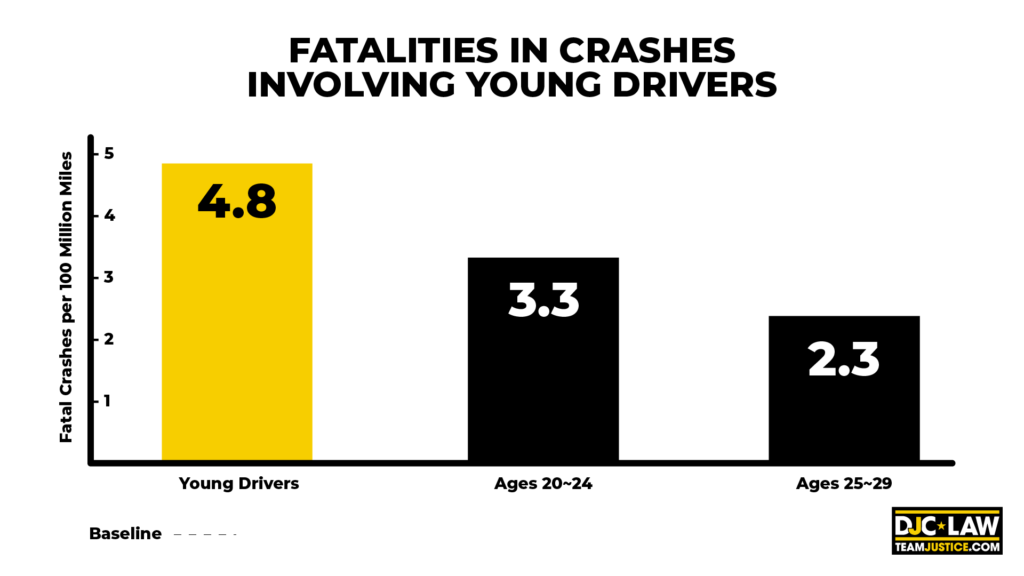
What is the Biggest Cause of Teen Crashes?
The biggest cause of teen driver traffic crashes is inexperience. Novice drivers have an increased risk of critical errors that could result in accidents. According to Teen Driver Source, 75% of serious teen driver car crashes arise from driver error. Even more interestingly, they found that three errors represent 50% of these accidents:
- Lack of scanning to pinpoint and respond to hazards.
- Driving too quickly for the road conditions.
- Being distracted by something inside and outside the vehicle.
Another stunning statistic is the severity of these accidents. Teen Driver Source also reported that 60% of pediatric spinal fractures in children appeared between the ages of 15 and 17. Of those injuries relating to this age range, motor vehicle crashes were the leading cause.
What are the Most Common Risk Factors for Teen Drivers?
Driving is a skill that only gets better with time and experience. Newly legal drivers are the most vulnerable because driving schools can only teach so much. There’s no substitute for experience, which is why distracted driving, speeding, and lack of experience are three of the biggest risk factors faced by teen drivers.
Let’s explore the most common risk factors experienced by teen drivers in the U.S.
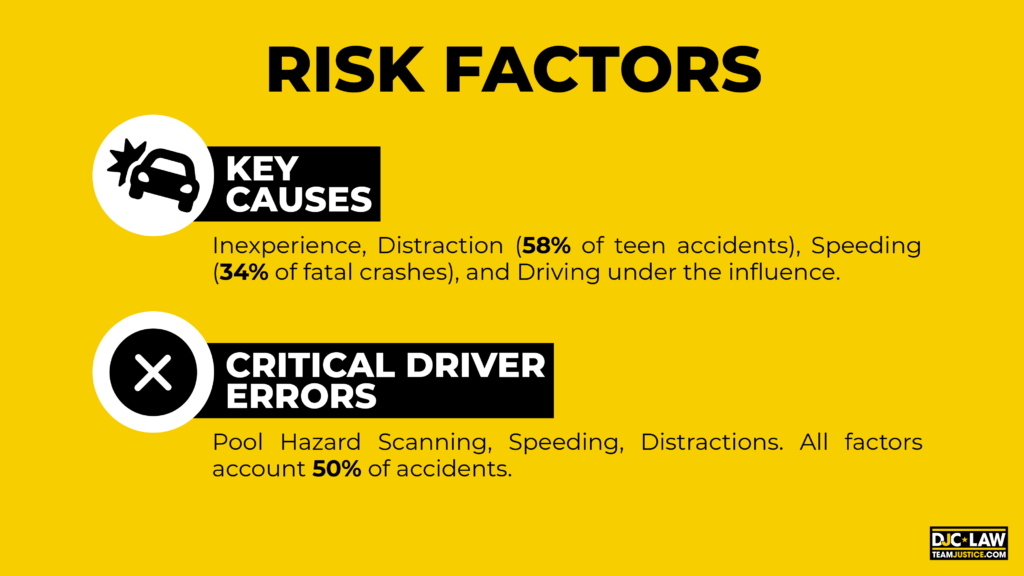
Distracted Driving
With so many distractions in life, it’s easy to become distracted by something inside or outside the vehicle. Whether it’s a billboard that catches your attention or a call on your cell phone, the temptation to take your eyes off the road and your hands off the wheel is enormous.
According to the Top Driver driving education school in Illinois, more than 58% of teen driver accidents were caused by distracted driving. Even though texting and driving has been outlawed in the state for some time, teenagers continue to get distracted by their phones, with disastrous consequences.
However, distractions can arise from everywhere. Other examples include:
- Eating while driving.
- Drinking while driving.
- Daydreaming.
- Talking to other passengers.
- Changing the radio station.
Good driving habits mean keeping both hands on the wheel, two eyes on the road, and putting your mind to what’s happening around you.
Speeding and Reckless Driving
Speed kills for every age group. Unfortunately, the Governors Highway Safety Association (GHSA) reported that over a single five-year period, 4,930 teenage drivers and teenage passengers were killed in crashes caused by speeding.
It’s no secret that teens are the group you’re most likely to find engaging in reckless driving. The GHSA found that drivers aged 16 to 19 made up 34% of fatal crashes involving speeding, with the 20-29 demographic not far behind at 33%.
Why do teens speed more than any other age group?
In short, it’s all down to the traditional teenage mentality that leads them toward risk-taking behavior and a lack of self-preservation. They aren’t fully formed adults and are naturally more impulsive than older adult drivers.
Driving Under the Influence
Teenagers also have a higher chance of being killed due to driving under the influence. This is in line with drivers in their formative years beginning to experiment with alcohol and other substances for the first time.
Despite teen death rates gradually decreasing, drunk driving fatalities in the under-21 demographic is actually spiking. According to Responsibility.org, the fatal accident rate per 100,000 of the population has risen by 33% over the last decade.
Lack of Driving Experience
Any teenage driver’s biggest weakness is their lack of driving experience. The decisions that an older driver with years’ worth of experience would make differ from those who are new to the roads.
Unfortunately, driving schools can only offer the basics, but they can’t provide the confidence that enables drivers to make good decisions when encountering different scenarios. With more vehicles on the road than ever, teenagers have never been more vulnerable to making the wrong decisions that could result in an auto accident.
How Can Teens Reduce Their Risk on the Road?
Many accidents involving teens are self-inflicted, with young drivers making the wrong decisions. Whether failing to buckle up, driving after a couple of beers, or taking undue risks, teens can dramatically reduce the chance of being involved in an accident by thinking about how they drive.
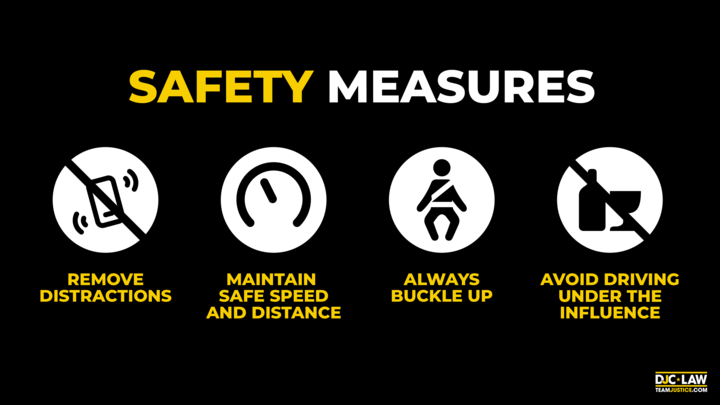
Teen Driver Safety Tips
Are you a teenager who’s just got their driver’s license or a concerned parent worried about letting their teen loose on the road?
Follow these teen driver safety tips to ensure a safe journey every time.
Get to Know Your Car
Before you operate your car, you need to know how it works. Take some time to look through the owner’s manual so you know what all the buttons and indicators do. The last thing you want is to go through trial and error in the middle of the freeway.
It’s also worth knowing some basic car maintenance to save some money and to dig yourself out of a hole if you get into trouble. Think about how to change a tire, check tire pressure, and how to pop the hood.
Remove Distractions
Remove anything and everything that might draw your attention away from the road. Some of the most common distractions include:
- Eating
- Drinking
- Noisy teen passengers
- Texting
- Calling
Over time, you’ll get used to putting any distractions out of your mind. In the meantime, it’s wise to take extra steps to avoid getting tempted. For example, consider putting your phone in the glove compartment while moving.
Maintain Distance
Getting rear-ended or fender-bending someone else isn’t just embarrassing but dangerous. Vast numbers of Americans are injured every year because they don’t give themselves enough space between their cars and the vehicle in front.
Practice leaving plenty of space between you and anything in front of you so that you’ve got the chance to brake or change lanes. You should be checking your mirrors every 15-30 seconds to detect hazards.
Watch Your Speed
Speed limits aren’t there because society hates fun but because they save lives. Speeding doesn’t just make you liable for a ticket and increases your chances of losing control of your vehicle.
Watch your speedometer and try to drive just under the speed limit. Likewise, don’t drive too slowly, either. Driving too slow is just as dangerous as driving too fast.
Buckle Up
Seat belts stop you from flying through the window like a human missile. They’re perhaps the single most important safety mechanism ever installed on a car. Not only is it illegal to drive without a seat belt, but it’s also putting you at risk.
If you’re driving with a child, ensure you’ve got the proper booster seat or child restraint system before pulling away.
Understanding Nighttime Driving Takes Some Extra Experience
More accidents happen at night than at any other time. Reduced visibility, opportunities to speed, and a greater chance of encountering someone driving under the influence all result in a higher chance of an accident.
Some states have also introduced nighttime driving bans for teenage drivers, meaning they can’t drive between certain hours without a guardian.
If you can drive at night, don’t be afraid to dial down your speed and pay extra attention to the roads. Driving at night can be scary, but you’ll get better with experience and obeying the rules of the road.
Teen Driver Insurance
Teen driver insurance rates are higher than those of any other age group because of the extra risk associated with teen drivers. Auto insurance providers are well within their rights to charge extra because of your age, regardless of how good or bad of a driver you actually are.
Here’s what you must know about teen driver insurance premiums.
How Much is Insurance for a Teen Driver?
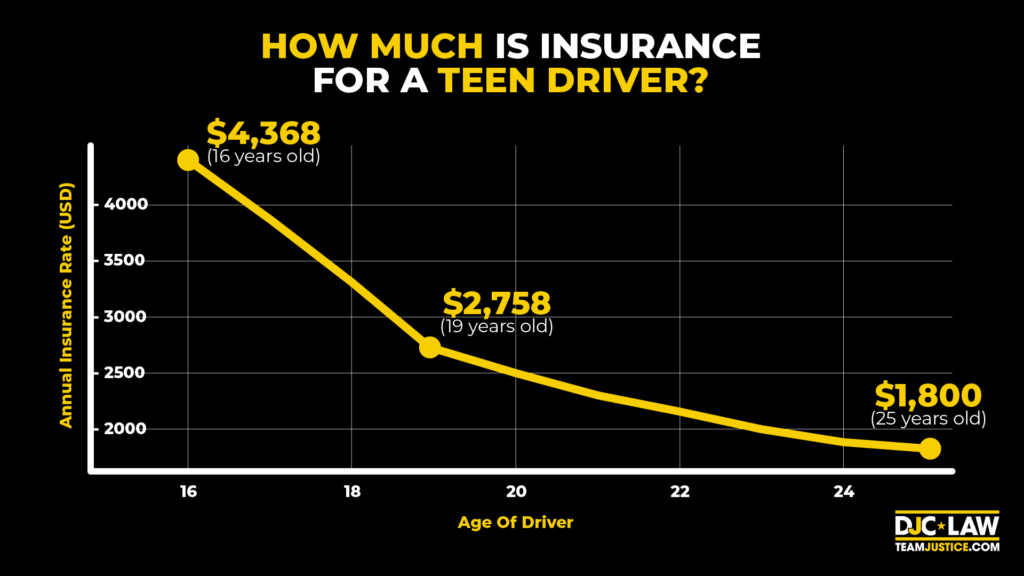
Teen driver rates start at $4,368 per year for 16-year-old drivers, per AutoInsurance.com, but this declines with every passing year. For example, the average annual auto insurance cost for a 19-year-old is $2,758. Generally, auto insurance rates start to normalize after a young driver passes the age of 25.
How to Get a Good Deal on Car Insurance as a Teen Driver
Getting a good deal on car insurance is tough because practically every insurer charges the highest rates for drivers in this age group. Shopping around helps, but there are other steps you can take to get a better deal on their auto insurance.
Proven methods to get a better deal on teen auto insurance include:
- Add Your Teen to an Existing Policy – Put your teen on your existing insurance policy instead of getting them their own policy. This is the best way to slash their auto insurance premiums.
- Drop Unnecessary Coverage – Take out the state’s minimum coverage and drop everything else. Note that this could result in you paying more later if your teen has an accident, so think carefully.
- Raise Your Deductible – Your deductible is the amount you must pay before your auto insurer covers any costs. Raising this deductible reduces your premiums automatically.
- Install GPS – Work with an insurer that offers discounts if your teen elects to have GPS navigation installed on your vehicle.
- Take a Class – Some insurers will lower your teen’s premiums if they take an approved driver training or defensive driving class. It’s a good idea to do these classes anyway to ready your young person for the road.
- Good Student Discounts – Did you know that some insurers will lower their premiums for kids with good grades? If these insurers are available in your area (and your kid has good grades), take advantage of these discounts.
- Pay-Per-Mile Insurance – Teens who only drive to and from school may benefit from pay-per-mile insurance. As long as they’re not planning a cross-country road trip, this type of insurance often works out cheaper than an ordinary policy.
What to Do if Your Teen Driver is in a Car Accident
Finding yourself in a car accident is traumatizing at any age, but if your teen is involved in an accident, it’s scary. However, what you do in the immediate aftermath is crucial. Ensure that your teen knows what to do if they collide with anything. And don’t be afraid to hire an expert personal injury lawyer to pursue a fair settlement if your teen sustains injuries.
Here’s your guide to managing the process from start to finish.
Steps to Take Immediately After an Accident
Educate your teen on what they should do after an accident because if they make the wrong move, it could impact their ability to file an auto insurance claim or pursue a personal injury lawsuit later.
Here are the steps to take immediately after a car accident, including minor ones:
- Step One – Move to a safe area if the car is still drivable. Don’t just sit in the middle of a busy road. The priority is to get to safety. Check for any injuries in the meantime.
- Step Two – Call 911 and ask law enforcement to attend in all cases so they can compile a car accident report. If they’re seriously hurt, they should call for an ambulance.
- Step Three – Ensure they exchange contact details and insurance information with any drivers involved. This is a legal requirement, and failing to do so is a crime. Likewise, they shouldn’t leave the scene of an accident until the police arrive.
- Step Four – If safe and able, take photos of the scene using their phone. This evidence could enable them to prove that the other driver was at fault if they’re in a state with at-fault laws, like Illinois.
- Step Five – Through their parents, they should get in touch with a lawyer who can potentially pursue an insurance claim or lodge a personal injury lawsuit.
And don’t forget to tell them to call home immediately to tell their loving parents what happened!
Filing an Insurance Claim
How you file an insurance claim depends on the scenario. If someone crashes into you, the simplest way is to claim against the other driver’s liability insurance, known as a third-party claim. However, don’t expect a quick payment because the other insurer will probably want to investigate the incident.
Your other option is to claim with your insurer. What actually happens depends on if you live in a no-fault or at-fault state. Here’s how the process differs:
- No-Fault States – No-fault states mean you always claim for injuries with your own insurer first. Only when certain qualifications are met can you sue the other driver in court.
- At-Fault States – In an at-fault state, you sue the other driver’s insurer by filing a claim with them. Who was at fault will determine whether you win damages.
Alternatively, or simultaneously, depending on the situation, you can hire a Chicago car accident attorney to sue the other driver. This also works if the other driver has no insurance or is underinsured. How the process works and when you can claim depends on the state you live in.



